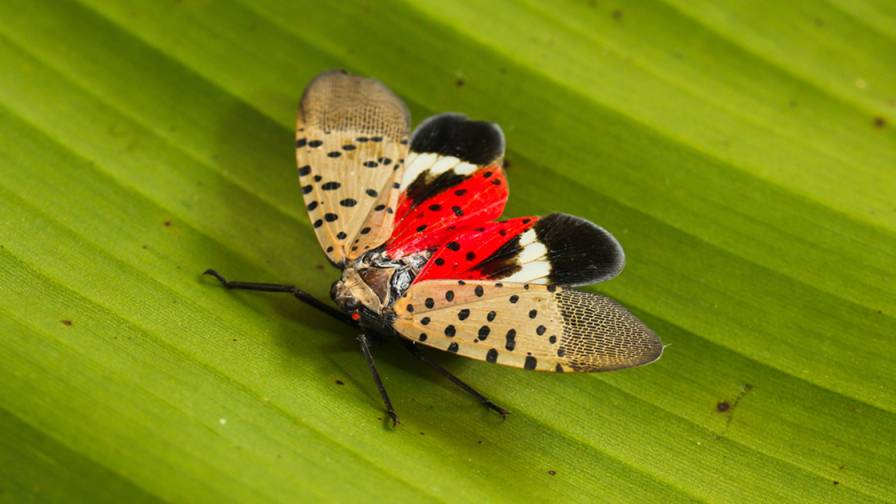Spotting a Growing Invasive Threat: Spotted Lanternfly
The number of invasive species we deal with seems to increase annually. From fields to orchards to vineyards, and even urban environments, invasive species can spread quickly and cause distress to growing environments, due in part to a lack of natural predators and the interconnected nature of commerce.
The spotted lanternfly, Lycorma delicatula, is a prime example of one we’ve been tracking, and one specialty crop operations should be keeping an eye on. Native to Asia, spotted lanternfly was first detected in the U.S. eight years ago in Pennsylvania. Since then, the pest has spread to more than 11 states across the East Coast and Midwest.
Knowing the Impact Of Spotted Lanternfly
Pennsylvania has taught us quite a bit about the impact this species has on an operation. It’s estimated to cause damages upward of $325 million each year in Pennsylvania alone. A similar rate of economic impact is likely to occur in other states with similar cropscapes as it spreads.

Spotted lanternfly has the ability to rapidly produce eggs, making it a challenging invasive species. Photo: FMC.
Invasive species tend to be most successful if their life cycle and biology follow a similar pattern: numerous generations per season, producing a high volume of eggs, and the ability to reproduce on a multitude of hosts. Spotted lanternfly has the ability to rapidly produce eggs, making it a challenging invasive species. While it can only produce one generation per season, spotted lanternfly can lay one to two egg masses each, containing 30-60 eggs. Freshly deposited egg masses appear white and creamy, and then fade to a gray with a mud-like texture on tree bark, which effectively camouflages it from the untrained human eye.
As a spotted lanternfly feeds on the xylem and phloem of trees, it releases honeydew that consequently promotes the growth of fungi and can attract bees, wasps, and other organisms attracted to the liquid excrement. The feeding damage caused by spotted lanternfly can lead to decreased plant health and crop loss, and the honeydew can negatively impact crop quality.
Slowing the Spread
Based on the parameters of their native climate and where it’s already been found, it seems inevitable that the spotted lanternfly may be headed to the West Coast. It may no longer be an if, but when the spotted lanternfly will make its presence known in this region.
More than 70 plant species can serve as a host for spotted lanternfly to reproduce. This includes hardwood trees, fruit trees, and vine plants such as grapes and hops. One principal way to slow the spotted lanternfly’s spread to new geographies, like the West Coast, is to identify and remove the also-invasive tree-of-heaven, Ailanthus altissima.
Now, you may be asking yourself, what is the tree-of-heaven? It’s an invasive plant to the U.S. introduced in the 1700s and is spotted lanternfly’s preferred host. However, the sumac and several other native trees and tree-of-heaven have similar compound leaf structures and can be mistaken for one another. When deciphering which species you are dealing with, give the leaves a smell. Tree-of-heaven is known for its rancid peanut or ‘used gym socks’ smell. Numerous plant identification apps are also available to confirm correct identification.
Many states have developed prevention plans to slow or prevent the spread of spotted lanternfly. The first step is to identify where tree-of-heaven is located, especially when it occurs along transit routes (e.g., highways and rail lines), where the spotted lanternfly could hitch a ride. Washington state has an app to report tree-of-heaven among other invasive species to the state for removal.
But it’s not all doom and gloom. A significant amount of information has surfaced thanks to researchers, and there is technology at our disposal to help growers prepare. Consultants and retailers can combine data, field biology and multiscale modeling to predict the potential spread and impact of the spotted lanternfly. Knowing the vulnerabilities of the pest and options available will help growers combat spotted lanternfly when it spreads.
Other steps to reduce the spread:
- Keep your eyes peeled for the pest and egg masses. Familiarize yourself with spotted lanternfly’s distinct appearance.
- Inspect materials and equipment transported from spotted lanternfly hot spots.
- Identify and remove tree-of-heaven if it is on your property.
- Report tree-of-heaven to the state if it is located outside your personal property.
Having the Management Answers
It’s important to be aware of this pest but not to fear it. If it does spread, we have proven tools to manage it — ongoing research is also helping uncover new solutions for the pest. Utilizing insecticides with long residuals helps us control the succession of generations to eliminate the pest. Solutions like Brigade 2EC insecticide/miticide with the active ingredient bifenthrin can be used on grapes, hops and pears to manage for adult spotted lanternfly. Growers should also consider treating remaining tree-of-heaven with an insecticide for preventative management if removal is not an immediate option.
Spotted lanternfly and its spread is a progressing issue, and our retailers need to closely monitor the situation and their current status with this pest to best consult with their grower-customers when the time comes.






